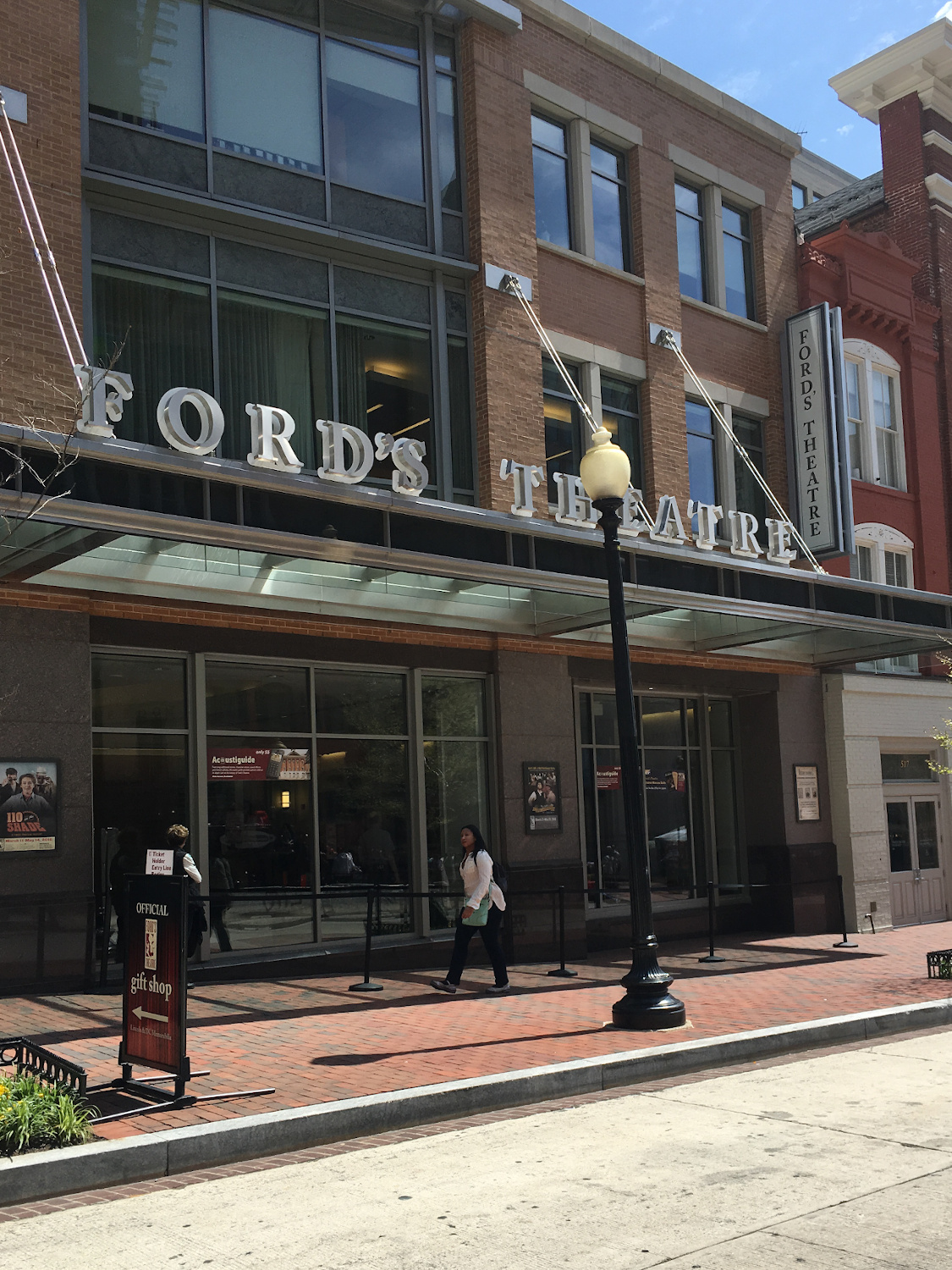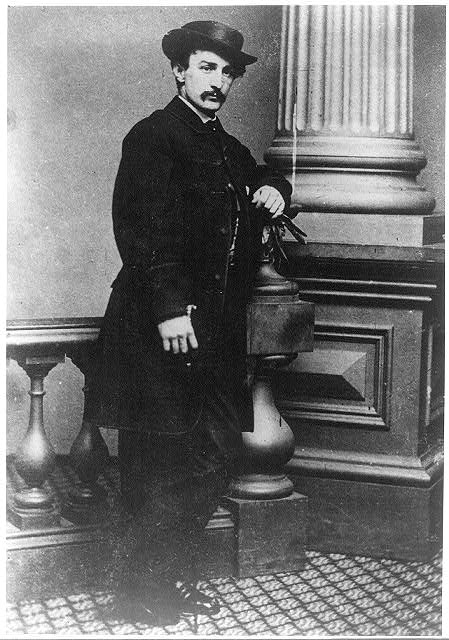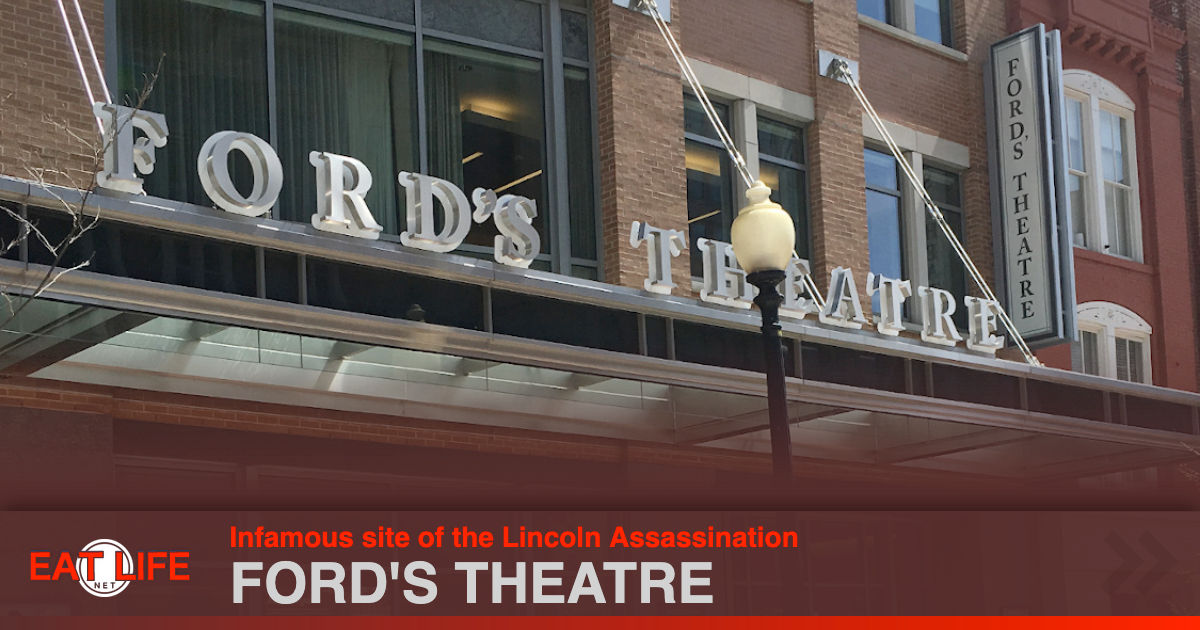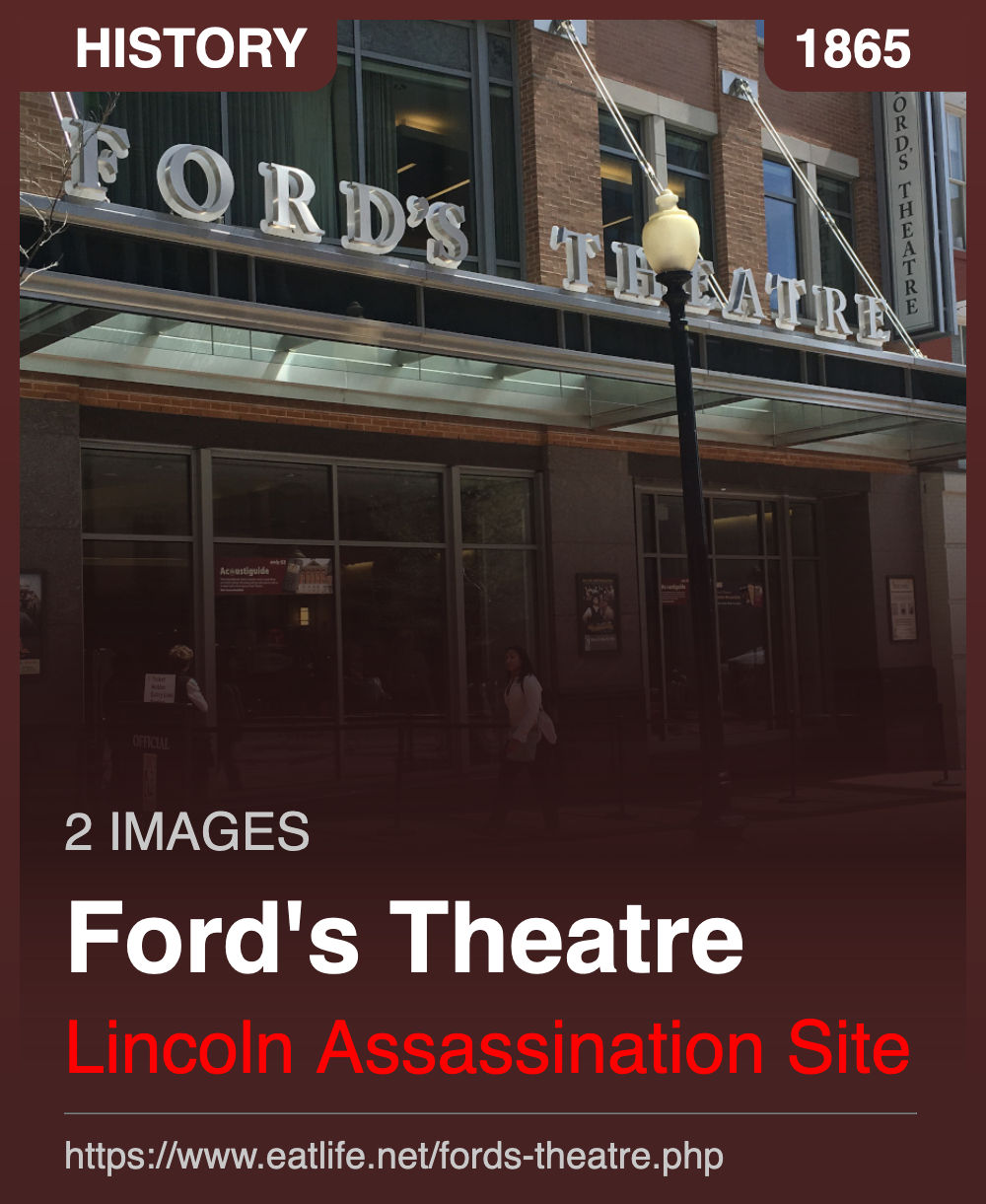
Ford's Theatre
Ford's Theatre in Washington, D.C. memorializes a day ingrained in American history: the day President Lincoln was assassinated.April 14, 1865:
Just five days after General Lee's surrender at Appomattox Court House, America's transfer from civil war to peace was made more difficult when Abraham Lincoln was shot and killed. John Wilkes Booth, a well-known actor, desperate to aid the dying Confederacy, stepped into the president's box. Booth's decision to pull the trigger altered the nation's power to reconstruct after the war. Booth escaped into the night as Abraham Lincoln was carried to the Petersen boarding house across the street. It was there that President Lincoln died early the next morning, and became the first American president to be assassinated.https://www.nationalparks.org/connect/explore-parks/fords-theatre-national-historic-site

https://www.google.com/maps/place/Ford's+Theatre+National+Historic+Site
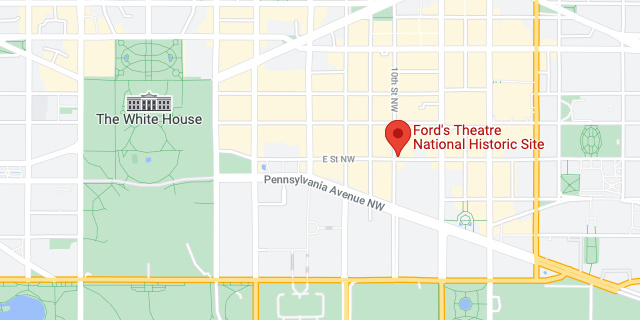
https://www.google.com/maps/place/Ford's+Theatre+National+Historic+Site
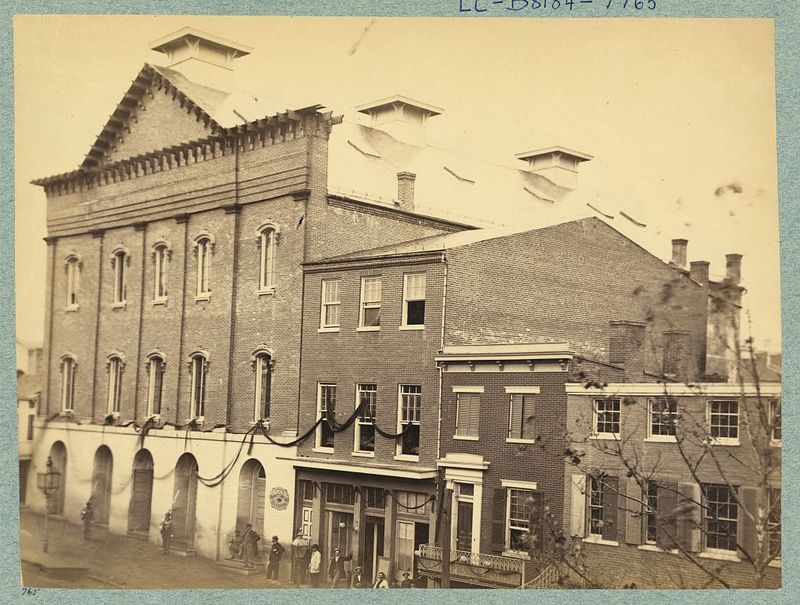
Ford's was built by Baltimore theater entrepreneur John T. Ford on the site of the First Baptist Church. Built in 1833, the church had been abandoned in 1859, and Ford had converted the building into Ford's Atheneum in 1862, but the Atheneum had burned later that year.
Construction on the structure that still stands today began in 1863 with James J. Gifford serving as the builder and architect. Following Lincoln's assassination in 1865, Ford briefly retained the notion of continuing to use the building as a theatre, but outcry from the American public forced him to abandon the idea. The still-unfinished building was seized in July of 1865 by order of the Secretary of War, and its interior was torn out in August of 1865.
The building was subsequently converted into a three-story office building housing the Army Medical Museum and Surgeon General. Rather than being recognized for its historical significance, the building was used for a variety of government purposes over the course of several decades. In 1893, a section of the interior collapsed, killing 22 people, and alterations to the building, including the facade, followed in 1894.
After many years of serving as storage space, Ford's Theatre was transferred to the ownership of the National Park Service in 1931, and in 1967, the building was restored to its 1865 appearance.
 Currently, the building continues to stage plays and operate as a theatre, in addition to hosting a museum relating to the Lincoln assassination.
Currently, the building continues to stage plays and operate as a theatre, in addition to hosting a museum relating to the Lincoln assassination.
 Following Lincoln's death:
Following Lincoln's death:After the President was fatally shot, the nation went into mourning and the Theatre went into darkness for over one hundred years.
The public demanded the closure of the Theatre, threatening the building with destruction and its owners with bodily harm. For almost ninety years, Ford's Theatre no longer functioned as a theatre, but instead served intermittently as a museum, office space and storage facility.
In 1954, President Dwight D. Eisenhower signed a Congressional act to restore the Theatre, and reconstruction began ten years later. Frankie Hewitt, who had lobbied to have the Theatre restored to its former glory, founded the Ford's Theatre Society, a not-for-profit organization with the sole rights to produce within the space. Due in large part to her extraordinary efforts, Ford's Theatre reopened in 1968 as both a historic site and working theatre, and has since presented more than two hundred plays, musicals and special events.
https://www.americanheritage.com/content/fords-theatre-national-historic-site
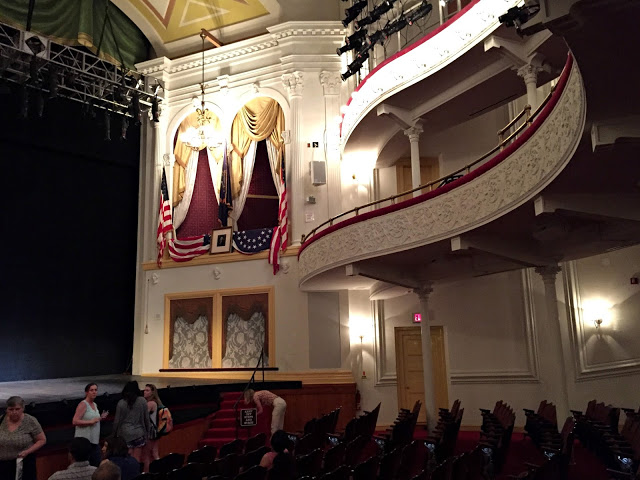
The President often visited Ford's Theatre, to relax and enjoy his love of the theater.
Lincoln was shot while attending a performance of the comedy, Our American Cousin at Ford's Theatre accompanied by his wife, Marty Todd Lincoln, Major Henry Rathbone and Rathbone's fiance, Clara Harris. They were late, but the play, Our American Cousin, was interrupted when they entered the presidential box so the band could play "Hail to the Chief" and the audience could deliver a standing ovation to the couple.
https://gratefulprayerthankfulheart.com/fords-theatre-lincoln-presidential-box
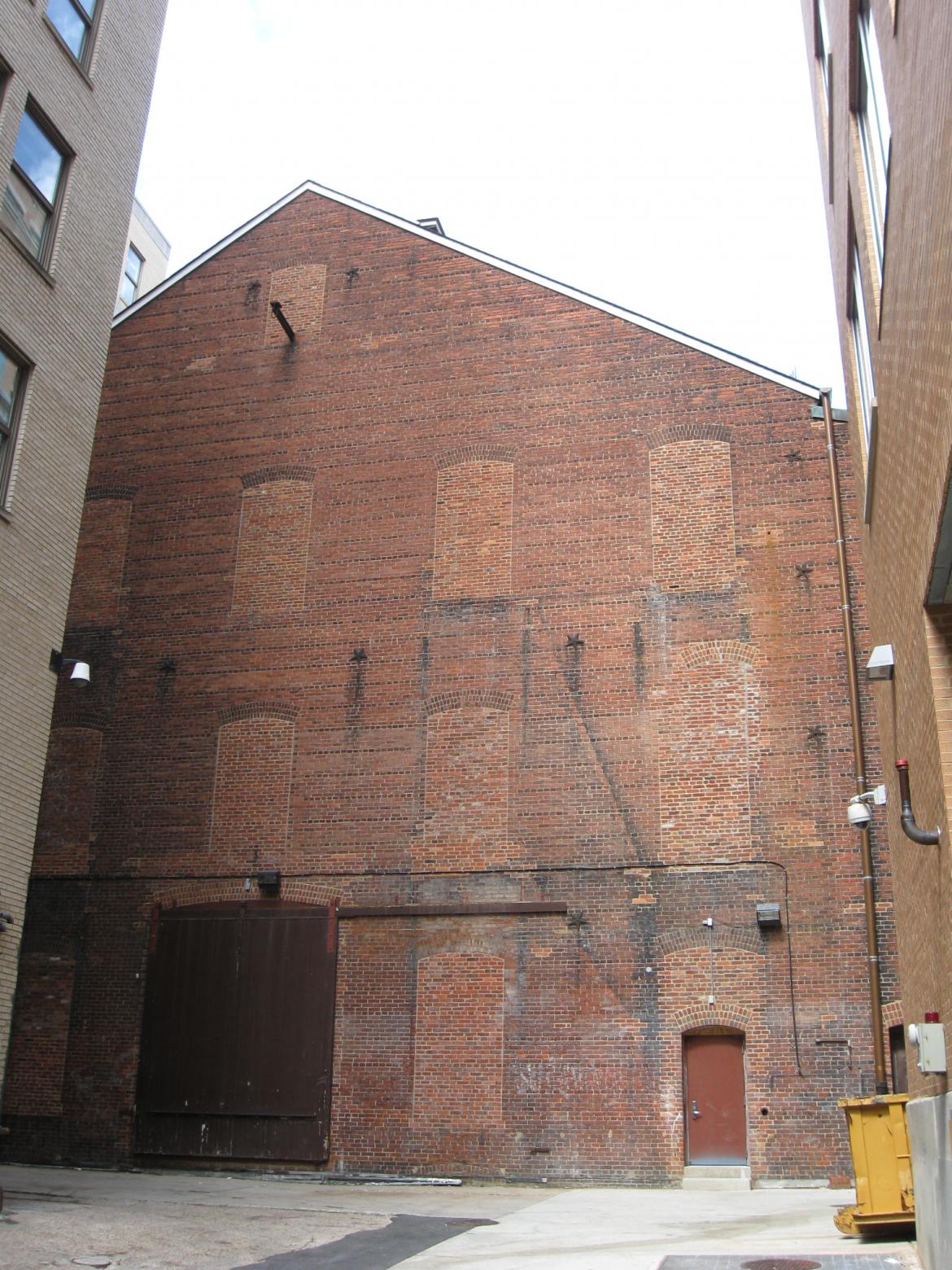
- After his meeting in the Herndon House with his co-conspirators, John Wilkes Booth arrived back at Ford's Theater around 9:00 PM.
- Booth entered the Theater, went underneath the stage from right to left or north to south while the play, "Our American Cousin" was being performed
- Then he exited Ford's Theater into the small alley
- He then entered Taltavul's Star Saloon to have his whiskey and water
- Then he entered the lobby of Ford's Theater
- and moved upstairs to the dress circle

- Booth walked behind the audience in the dress circle
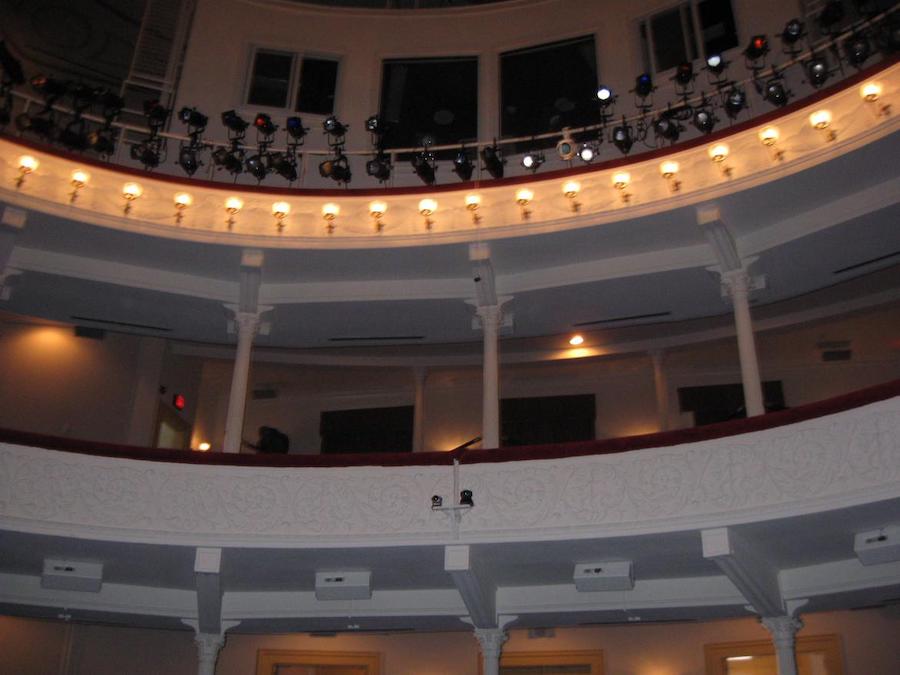
- He then presented his card to Lincoln aide Charles Forbes at the yellow door outside the Presidential Box
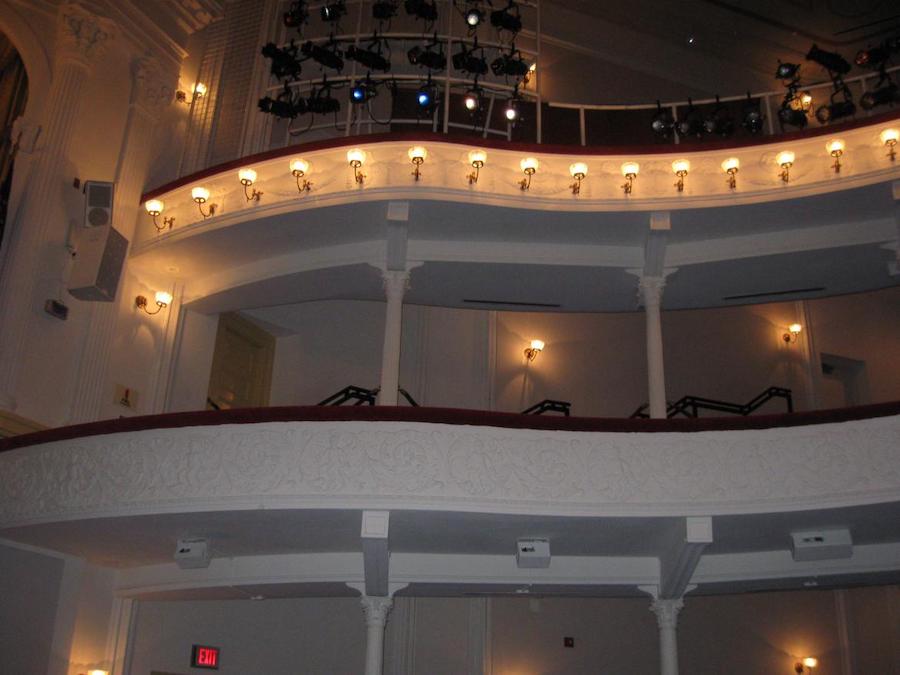
- Booth then barred the door to the box to keep others from entering, and shot President Lincoln in the back of his head
- After shooting Lincoln, Booth struggled with Major Rathbone, and may have caught his spur on the dark blue U.S. Treasury Flag in the middle of the outside of the box.
- Booth then jumped to the stage and may have fractured his leg. At least one historian believes that Booth fractured his leg later that night when his horse fell. Booth raised a knife he was carrying (and which he stabbed Major Rathbone) over his head and yelled, "sic semper tyrannis! (thus always to tyrants)"
- Booth then limped (or ran) to across the stage to the rear door of Ford's Theater
- John Wilkes Booth then ran out the stage door where "Peanut" Burroughs was holding Booth's horse
- After mounting his horse, Booth began riding down Baptist Alley
- At F Street it is believed that he took a right, and headed towards the area of the United States Capitol and then to the Navy Yard Bridge.
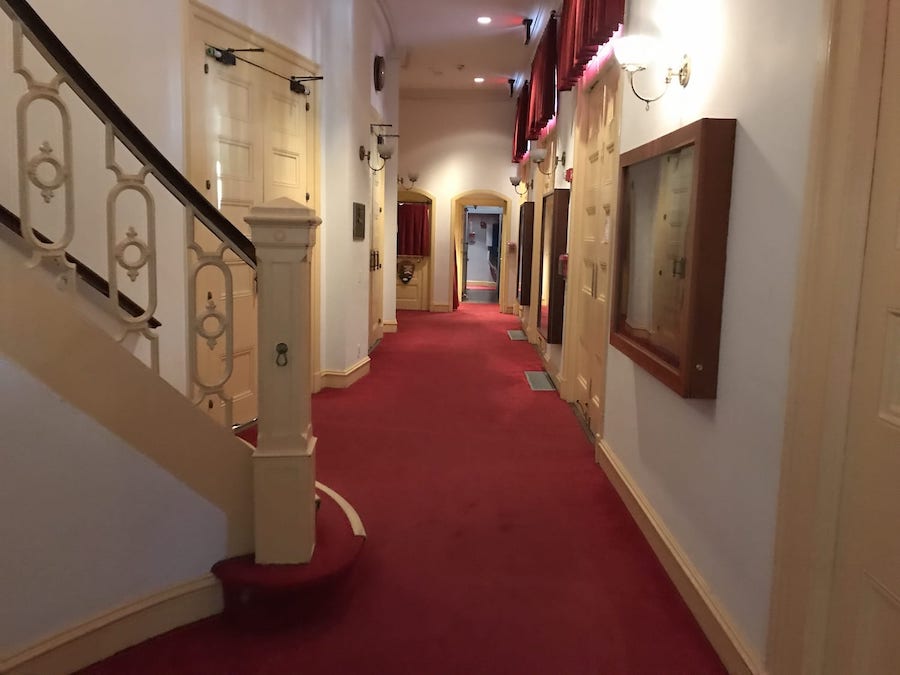
Though this is not the original interior, it has been recreated to look the same as it did on the night that President Lincoln was assassinated.

https://www.historictheatrephotos.com/Theatre/Fords-Washington-DC.aspx
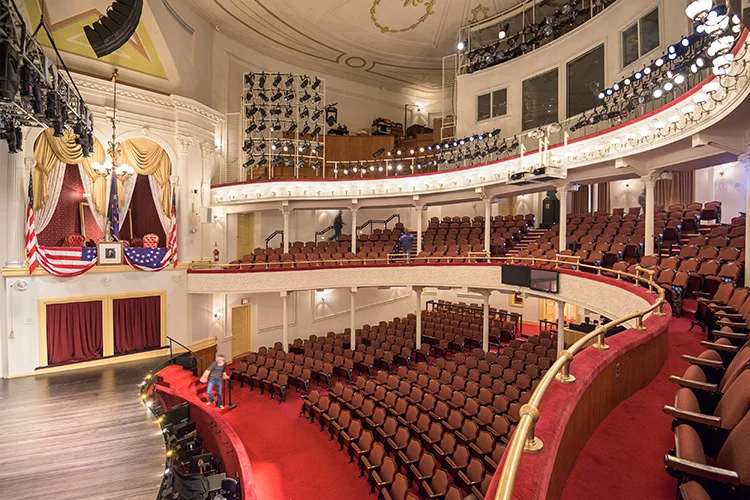
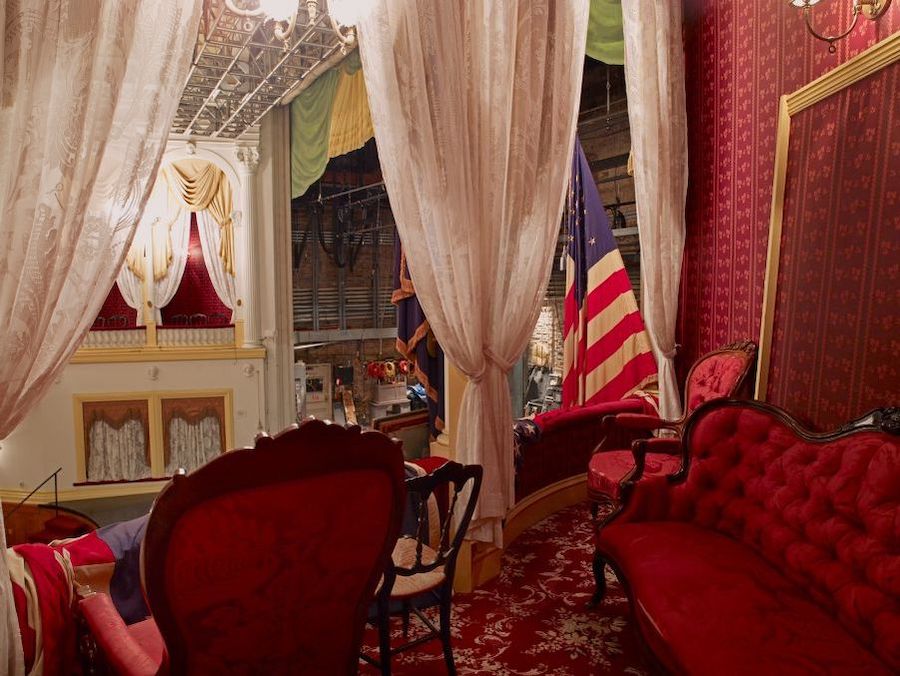
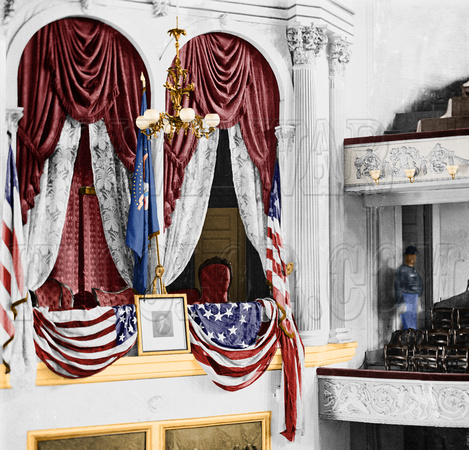
Here, Lincoln was assassinated on April 14, 1865. In the Box, Lincoln & his wife Mary were seated on the right with Henry Rathbone & his fiance Clara Harris seated on the left. Proprietor John Ford had a rocking chair, now referred to as the "Lincoln Chair", moved into the Box for Lincoln's comfort.
The Box was decorated with borrowed flags in honor of Lincoln's twelfth visit. American flags were reportedly in short supply in the capital, and it is well established that the theater borrowed flags to decorate the Presidential box. The borrowed blue Treasury Guard regimental flag was hung from a staff fixed to the pillar between the two boxes. It was this flag that tripped John Wilkes Booth.
The regimental flag has also been identified as "being in the grasp of the President when he was shot."

On the night of April 12, 1865, the Treasury Guard gave a ball at Ford's Theater. The theater was transformed into a large ballroom by the erection of a temporary flooring over the tops of the scats in the lower part of the house. The decorations were elaborate, and the flags of the guard were draped on the boxes. The guest of honor at that ball was Commodore Winslow of the Kearsarge. It was the first visit of that officer to Washington after the sinking of the Alabama.
It is narrated that after the ball John T. Ford requested the officer of the Treasury Guard to allow the flags to remain on the boxes as the President was expected to attend a performance at the theater the night of April 14.
It was in the knotted fringe of this old flag that one of Booth's spurs caught when he leaped from Lincoln's box at Ford's Theater on the night of April 14, 1863, after having mortally wounded the President and stabbed Maj. Rathbone. Had not the spur caught, Booth's leg would in all probability not have been fractured or injured and his capture would perhaps have been very much more difficult.
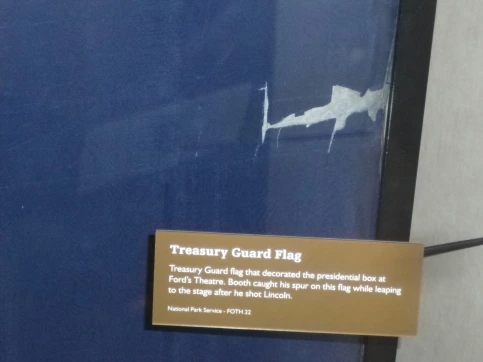
https://lincolnconspirators.com/2013/06/17/an-interesting-flag
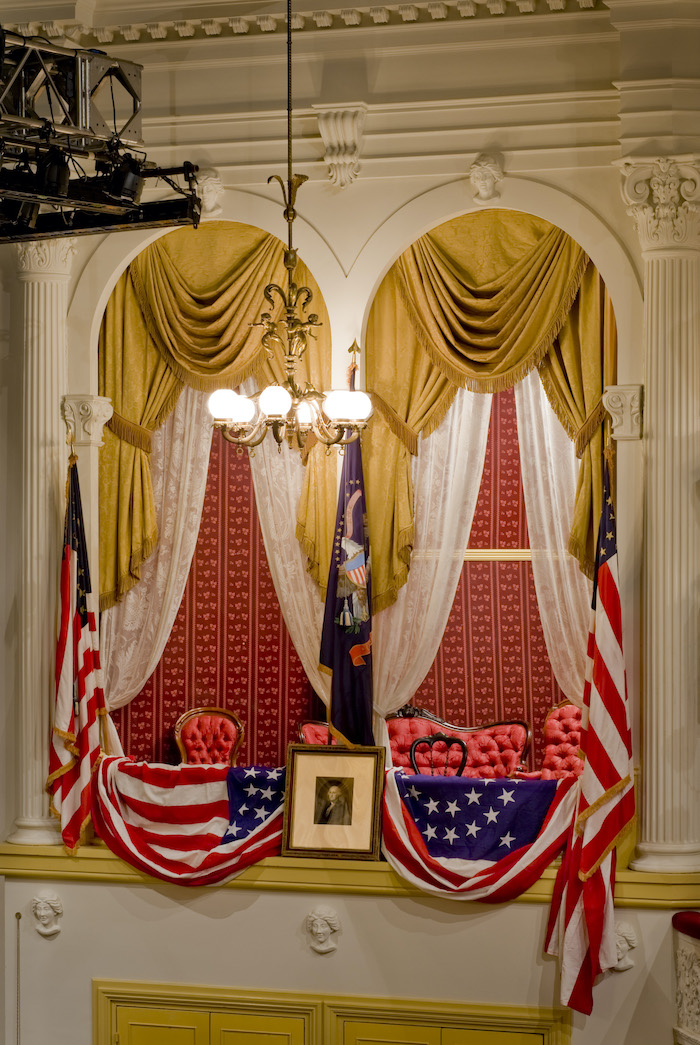
John T. Ford and the theatre's managers decorated the outside of the box so the audience would know the president was in attendance. In 1865, no presidential seal or official symbol of the presidency existed, so we believe that Ford chose the George Washington portrait to make allusions to the presidency. At the time, it was not uncommon to see representations of George Washington as a symbol of national unity and patriotism, just as today we recognize images of the eagle or flag in the same way.
Is the portrait on display the original?
National Park Service curators removed the original in August 2015, and the portrait currently on view is an exact replica. The frame of the original George Washington portrait is nicked on its upper-left corner. The indentation was said to be made by assassin John Wilkes Booth's spur as he jumped from the Presidential Box after he shot the president and ran to his waiting horse in the theatre's back alley.

John T. Ford's great grandson, Addison Reece, donated the original George Washington portrait and several other items from the night of the assassination to the National Park Service in 1959.
https://www.fords.org/blog/post/why-is-a-george-washington-portrait-on-the-ford-s-theatre-presidential-box
Q: What happened here?
Q: How many people were in attendance on the night of Lincoln's assassination?
Q: Who else besides President Lincoln was seated inside the state theatre box on the night of April 14th, 1865?
Q: Was anybody in the other boxes that night?
Q: What show was President Lincoln watching when he was shot, and what was it about?
Actress Laura Keene got hold of the script in New York in the late 1850's. Laura Keene did not consider the script to be of a high-quality. She thought that the only way the play would be a success was if she were to cast the highest quality actors of the time to perform within it. Two famous actors she recruited were Joseph Jefferson and Edward Askew Southern. E.A Southern agreed to play the part of the English aristocrat, Lord Dundreary, but only if he were allowed to completely ad-lib his part. He created a ridiculous stammer for his character and added a host of nonsensical aphorisms (e,g. "birds of a feather gather no moss") to his ad-libbed speeches. Joseph Jefferson, playing the role of Asa Trenchard was supposed to be the lead of the play, but instead E.A. Southern's role of Lord Dundreary took over the play, turning what was originally a melodrama into more of farce.
The play was a huge hit in New York in 1858 and then in London in 1861. It also created a merchandising boom related to the character of Lord Dundreary. The play made the careers of Laura Keene, Joseph Jefferson and E.A. Southern, each of whom had their own traveling productions of the play by 1865. Abraham Lincoln was watching Laura Keene's production of the play the night of the assassination.
Q: How old was President Lincoln when he was shot?
Q: What were Lincoln's last words?
Q: Where was the Secret Service when President Lincoln was shot? Why wasn't Lincoln guarded?
As for the evening of April 14, 1865, there was a lone Washington, D.C. police officer named John Parker assigned to escort the President from the White House to Ford's and back. His whereabouts at the time of the assassination are unknown. Some have suggested Lincoln may have invited him to take a seat with a better view elsewhere in the theatre. There is some evidence that he may have taken a drink over at the Star Saloon next door with the president's coachman and messenger at intermission, but there is no evidence on whether he remained there or not. Presidential security was a much more casual affair in the 19th century and keeping a constant guard on the president, as we might expect today, would not have been part of Parker's duties.
Q: Did theatre visitors witness the shooting?
https://www.nps.gov/foth/learn/historyculture/faq-the-assassination.htm
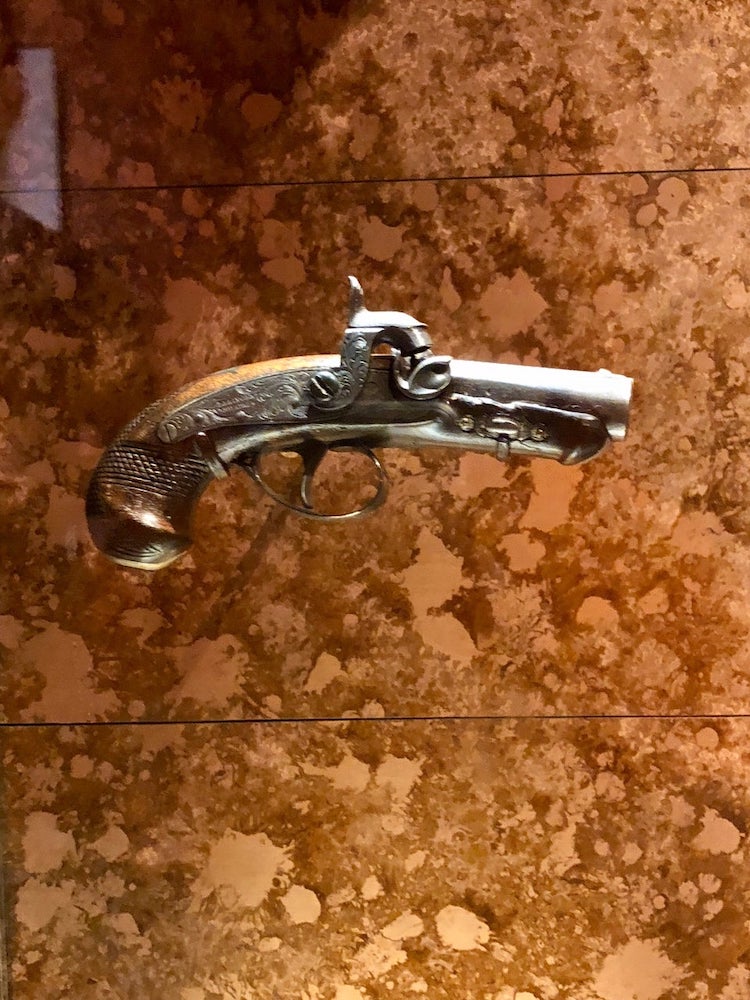
https://foursquare.com/v/fords-theatre/4a4826bef964a5209caa1fe3/photos
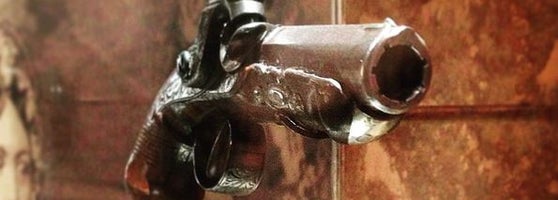
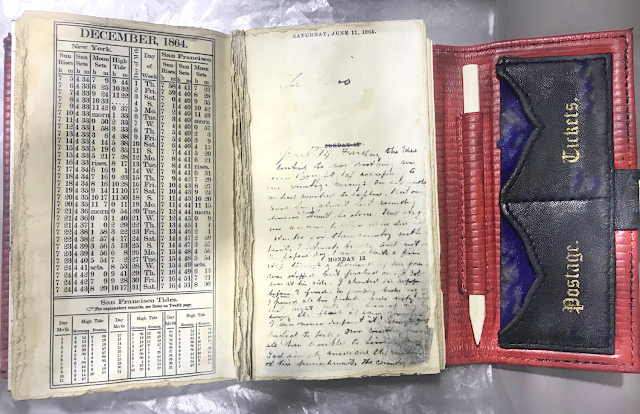
A small book, which was actually an 1864 appointment book kept as a diary, was found on the body of John Wilkes Booth on April 26, 1865. Mystery surrounds this diary. The little book was taken off Booth's body by Colonel Everton Conger. He took it to Washington and gave it to Lafayette C. Baker, chief of the War Department's National Detective Police. Baker in turn gave it to Secretary of War Edwin Stanton. The book was not produced as evidence in the 1865 Conspiracy Trial. In 1867 the diary was re-discovered in a "forgotten" War Department file with pages missing. Although most sources indicate 18 pages were missing the FBI's forensic laboratory has examined the diary and stated that 43 separate sheets are missing.
Booth's entries in the diary were probably written between April 17 and April 22, 1865. The text of the diary is as follows:
Until today nothing was ever thought of sacrificing to our country's wrongs. For six months we had worked to capture, but our cause being almost lost, something decisive and great must be done. But its failure was owing to others, who did not strike for their country with a heart. I struck boldly, and not as the papers say. I walked with a firm step through a thousand of his friends, was stopped, but pushed on. A colonel was at his side. I shouted Sic semper before I fired. In jumping broke my leg. I passed all his pickets, rode sixty miles that night with the bone of my leg tearing the flesh at every jump. I can never repent it, though we hated to kill. Our country owed all her troubles to him, and God simply made me the instrument of his punishment. The country is not what it was. This forced Union is not what I have loved. I care not what becomes of me. I have no desire to outlive my country. The night before the deed I wrote a long article and left it for one of the editors of the National Intelligencer, in which I fully set forth our reasons for our proceedings. He or the gov'r-After being hunted like a dog through swamps, woods, and last night being chased by gunboats till I was forced to return wet, cold, and starving, with every man's hand against me, I am here in despair. And why? For doing what Brutus was honored for. What made Tell a hero? And yet I, for striking down a greater tyrant than they ever knew, am looked upon as a common cutthroat. My action was purer than either of theirs. One hoped to be great himself. The other had not only his country's but his own, wrongs to avenge. I hoped for no gain. I knew no private wrong. I struck for my country and that alone. A country that groaned beneath this tyranny, and prayed for this end, and yet now behold the cold hands they extend to me. God cannot pardon me if I have done wrong. Yet I cannot see my wrong, except in serving a degenerate people. The little, the very little, I left behind to clear my name, the Government will not allow to be printed. So ends all. For my country I have given up all that makes life sweet and holy, brought misery upon my family, and am sure there is no pardon in the Heaven for me, since man condemns me so. I have only heard of what has been done (except what I did myself), and it fills me with horror. God, try and forgive me, and bless my mother. Tonight I will once more try the river with the intent to cross. Though I have a greater desire and almost a mind to return to Washington, and in a measure clear my name - which I feel I can do. I do not repent the blow I struck. I may before my God, but not to man. I think I have done well. Though I am abandoned, with the curse of Cain upon me, when, if the world knew my heart, that one blow would have made me great, though I did desire no greatness. Tonight I try to escape these bloodhounds once more. Who, who can read his fate? God's will be done. I have too great a soul to die like a criminal. Oh, may He, may He spare me that, and let me die bravely. I bless the entire world. Have never hated or wronged anyone. This last was not a wrong, unless God deems it so, and it's with Him to damn or bless me. As for this brave boy with me, who often prays (yes, before and since) with a true and sincere heart - was it crime in him? If so, why can he pray the same?
I do not wish to shed a drop of blood, but 'I must fight the course.' 'Tis all that's left to me.
https://drloihjournal.blogspot.com/2021/02/john-wilkes-booth-diary.html
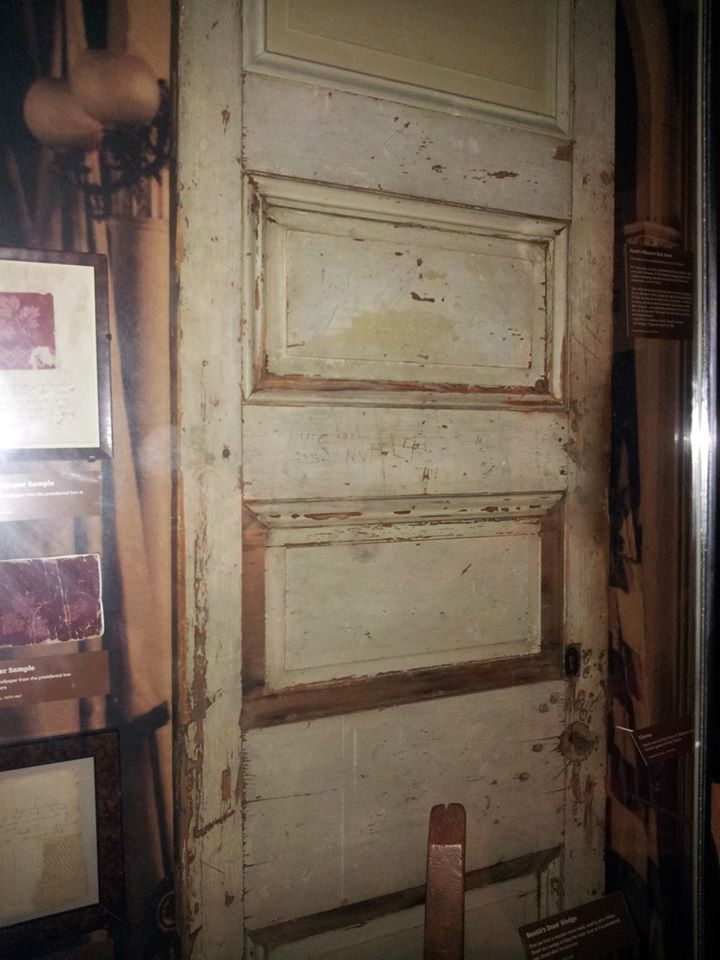
At about 10:25 pm, Navy Surgeon Dr. George Brainerd Todd witnessed a man referred to as "Booth" enter the doors to the Presidential Box. The man was famous actor John Wilkes Booth. The entrance into the Presidential Box was two sets of doors. After entering the outer doors, Booth was able to peer into the box through a hole carved into one of the doors, a hole he carved himself while planning the attack. Booth chose as his cue a key moment in the play, the speaking of the word "sockdologizing." This humorous word drew loud applause which could disguise the sound of a gun. The famous actor turned-assasin fired a bullet from a single-shot .44 caliber Derringer pistol point-blank into the back of Lincoln's head. Booth's easy access inside the theatre and past various guards is attribuared to his celebrity—even Lincoln had complimented Booth's acting in the past. But Booth was enabled by the president's lax personal security. His bodyguard, policeman John Frederick Parker, had left his post during intermission to go have a drink and did not return.
After the shot, Booth dropped his pistol and knifed Major Rathbone, who attempted to capture him. In the struggle, Booth leaped 12 feet off the balcony onto the stage, injuring his left foot upon landing. Booth allegedly yelled "Sic Semper Tyrannis" (latin for "thus always to tyrants") to the crowd and then escaped out a side door where his escape horse was being held by Joseph "Peanuts" Burroughs. Booth's actual words were disputed by eye-witnesses. Rathbone said he heard the word "freedom." Some said they heard only "Sic Semper." Other claimed English phrases such as "The South is Avenged," "Revenge for the South," "The South Shall Be Free," and "I have done it." Meanwhile, President Lincoln had slumped over from the shot, technically alive but mortally wounded. His body was carried across the street to a boarding house known as the Peterson House. Despite being attended by numerous doctors, Lincoln died of his wounds the next morning.
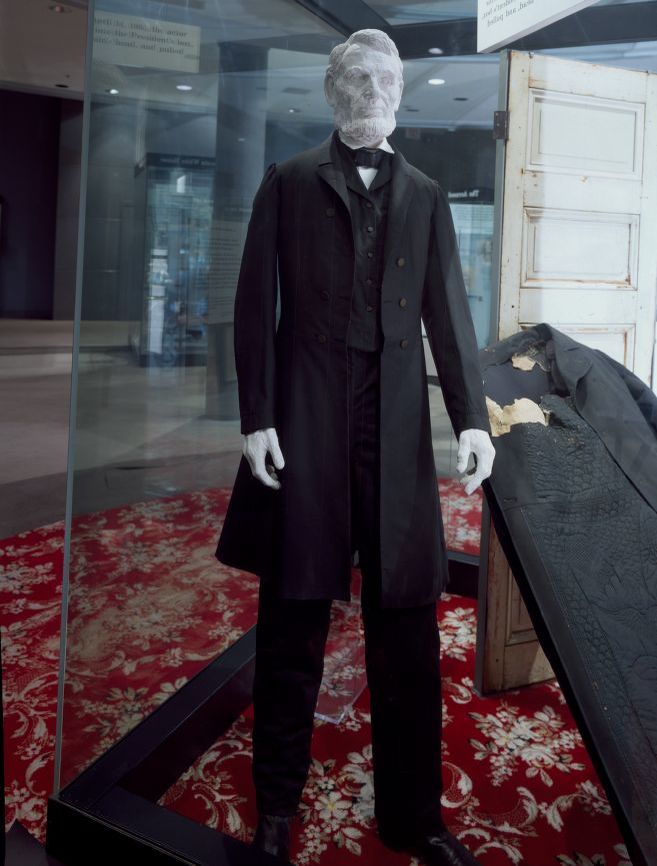
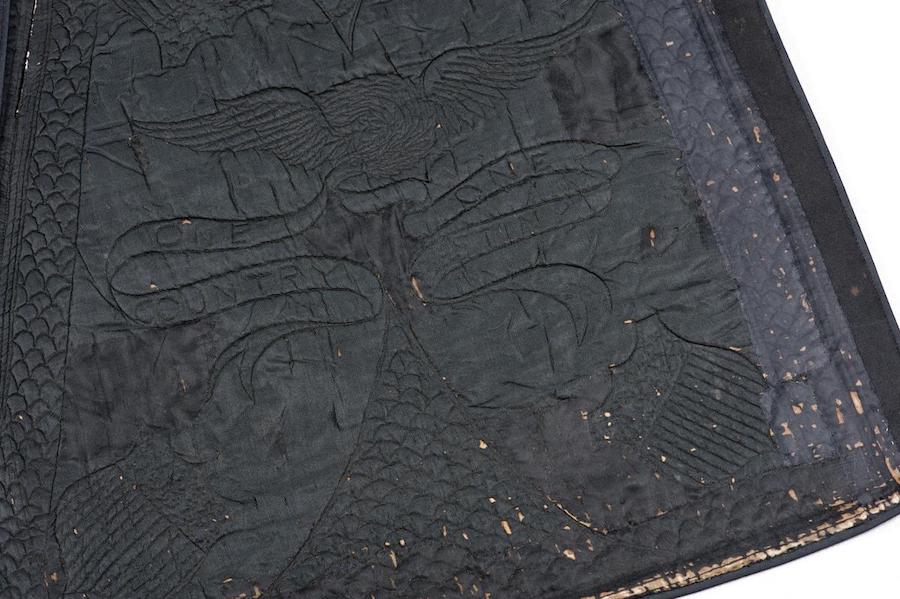
The inside linning of Lincoln's top coat. He asked a seamstress to emboss the words into the wool Brooks Brothers coat. He wore this coat for his second inauguration in 1865 and on the night he was assassinated six weeks later. Lincoln's blood spilled onto the shoulder of the top coat but not the lining. The spots seen here are due to age, not blood.
https://greensboro.com/news/lincolns-death-clothes-once-housed-in-greensboro-bank-vault
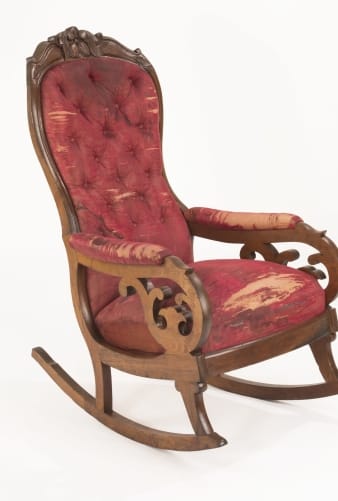
The comfortable parlor rocker had been placed in the theater box by the manager of Ford's Theatre for Lincoln's use that evening. After his assassination, enterprising photographers sold pictures of the chair to a public eager for images in an age before photojournalism. The chair was used as evidence in the trial of the conspirators. Then it languished in storage at the Smithsonian Institution for decades.
In 1929, the chair was reclaimed by the widow of Ford's Theatre co-owner Harry Ford, and was soon auctioned for $2,400. The buyer was an agent who purchased it for Henry Ford. At the time, Ford was collecting objects for his museum and historical village. For decades, visitors have sought out the Lincoln rocker at The Henry Ford.
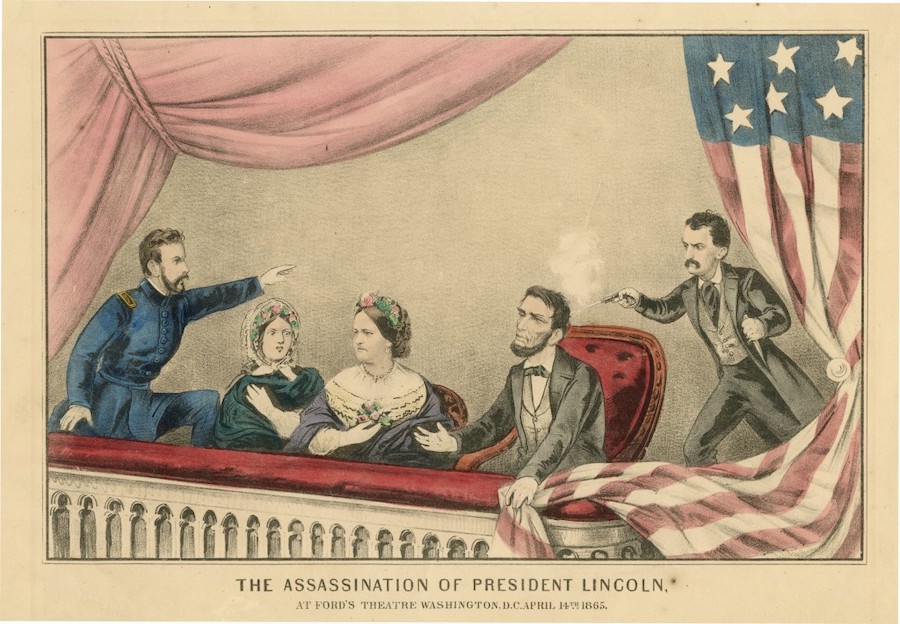
The details of the other couple in the Presidential Box that night, Clara Harris and her fiancee Henry Rathbone, have largely been forgotten. Unfortunately their tragic future was also determined by the horrors of that night.
Clara Harris was the daughter of Senator Ira Harris of New York. After Harris's mother died, her father married Pauline Rathbone. Henry Rathbone and Clara Harris were step-brother and sister but still fell in love and eventually became engaged to be married. Henry joined the US Army after the outbreak of the Civil War and saw many bloody battles. He had hoped to come home from the war, marry his fiancee, and move on with his life. Clara Harris had become friends with the First Lady through the Washington social scene. Others had been invited to Ford's theater that night, including Julia and Ulysses S. Grant, but all had turned down the invitation.
Lincoln was reportedly enjoying the play until Act III when John Wilkes Booth came into the Presidential Box and suddenly shot the President in the back of the head. Startled, Henry stood up and wrestled with Booth, who stabbed him severely in the arm hurting him from shoulder to elbow. As Booth began his escape, Henry screamed "Stop that man!" while Clara yelled, "The President is shot!" Seriously injured, Lincoln was moved to a house across the street from the theater and died the next morning with many in attendance, including Clara.
After the terrible night at Ford's Theater, Clara Harris and Henry Rathbone married and had three children. However, Henry was never able to get over what happened at Ford's Theater. He felt guilty for surviving the assassination and believed, as many had gossiped, that he should have done more to prevent the tragedy from happening. He felt he could never escape attention for being there that night and began to suffer from hallucinations and eventually declined into mental illness. On Christmas Eve in 1883 while living in Germany, he attacked his own family and himself. Almost imitating the assassination of years before, he shot Clara and stabbed himself several times with a knife. Clara died from the attack, and Henry was declared insane. He was committed to an asylum for the criminally insane in Germany and his children were sent to live with their uncle in the United States. Henry died in 1911 and was buried with Clara in a cemetery in Germany.
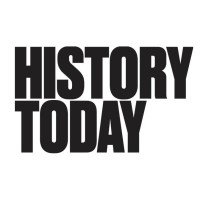 John Wilkes Booth:
John Wilkes Booth:Booth and a co-conspirator called David Herold escaped in the uproar from the Ford Theatre and rode away together. They fled south into Maryland, hiding in the woods and presently crossing into Virginia. Meanwhile, George Azerodt had made no attempt to kill the vice-president, but Lewis Powell had attacked and injured William Seward.
By April 24th Booth and Herold had reached Port Royal in Virginia, almost 90 miles south of Washington. The war department had offered a reward of $100,000 (worth more than $1.5 million today) for information leading to the arrest of Booth and his accomplices and federal troops were searching for them. The fugitives took refuge at the farm of a man called Richard H. Garrett, who apparently knew nothing of what had happened and let them sleep in one of his barns.
A band of soldiers arrived at the farm in the early hours of April 26th and surrounded the barn. Herold surrendered to them, but Booth defied them and they set the barn on fire. One of them saw Booth raise his gun to shoot – or said he did – and fired at him. Mortally wounded, he was dragged to the farmhouse where he died, after saying ‘Tell Mother I died for my country'.
https://www.historytoday.com/archive/months-past/death-john-wilkes-booth
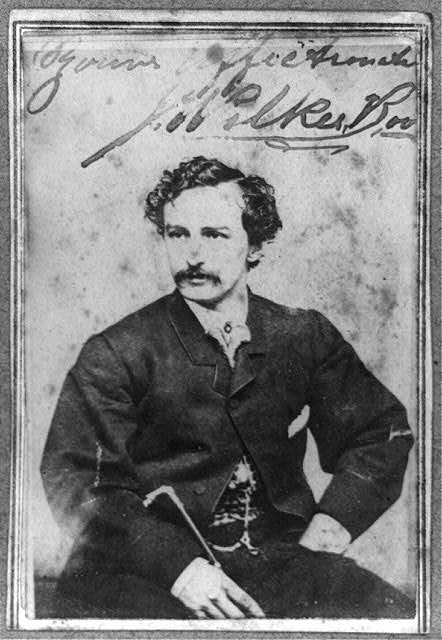
Q: Why did John Wilkes Booth assassinate President Lincoln?
As the Civil War dragged on and the horrific death and destruction which followed in its wake continued, John Wilkes came to believe more and more that President Lincoln himself was ultimately responsible for this misfortune upon the country and particularly upon the people of the South. Booth came to believe that if the North prevailed over the South, President Lincoln would then make himself into a permanent ruler or king monarch similar to Ancient Rome's Julius Caesar and as a result, America's republican form of government would be forever doomed.
Booth sought to assassinate the political head of the regime as opposed to the military, thereby giving the Confederate South perhaps a chance to attain its independence as a separate country. Booth's plan, however, immensely backfired and caused the South much more loss and difficulties. Most historians today agree had President Lincoln lived to oversee the country re-united, the South would have been somewhat spared much of its subsequent ordeal.
Q: Was John Wilkes Booth able to roam the theatre at will?
Q: Was John Wilkes Booth carrying any other weapons when he entered the state presidential theatre box?
Q: What is the distance from the Presidential Box to the stage?
Q: How did John Wilkes Booth break his left leg?
Q: How did Booth escape the theatre?
Q: Did John Wilkes Booth act alone, or was he part of a larger conspiracy?
Booth alone was the master mind in the plan to assassinate not only President Lincoln on the night of April 14th, 1865 but also Secretary of State William Seward and Vice President Andrew Johnson. Booth assigned Lewis Powell and George Atzerodt, respectively, to carry out those assassinations. Of the conspiracy to assassinate, we now know that Powell, Atzerodt and David Herold all had knowledge and were complicit in the President's murder that day. The question of Mary Surratt's guilt or innocence regarding knowledge of Booth's plan to murder Lincoln, however, is still debated and somewhat controversial among historians.
Most people subscribe to the simple conspiracy theory positing that Booth and nine other conspirators were responsible for the assassination as described above. Probably the next most popular conspiracy theory would be the "grand" conspiracy theory which posits high level confederate government involvement in the assassination.
Some historians argue that the assassination was part of a broad Confederate attempt to kidnap Lincoln that morphed at the last minute into a murder plan. "Grand conspiracy" historians speculate that Jefferson Davis may have had knowledge of an earlier plan to blow up the White House while Lincoln and his cabinet were in attendance there just days prior to his assassination. Four days before the assassination, John S. Mosby's men had been assigned to escort a bomb maker from the Confederate government's torpedo bureau into Washington to blow up the White House. Some evidence also suggests a money trail involving the Confederate Secret Service and Booth that linked the actor via his travel schedule to a Confederate clandestine apparatus that was run out of Montreal, Canada and included agents in the Northern Neck of Virginia and Southern Maryland. Though the circumstances are suggestive, no definitive evidence connecting these efforts to the Confederate leadership has yet emerged.
Q: How many conspirators altogether were tried and convicted in their involvement with John Wilkes Booth?
Three others of the conspirators were found guilty of conspiracy to kidnap President Lincoln. They included Samuel Arnold, Michael O'Laughlin and Dr. Samuel A. Mudd, all of whom were given life imprisonment sentences. The eighth conspirator to be sentenced was Edman Spangler who was found guilty of aiding Booth's escape out of Ford's Theatre by deciding to have his horse held for him behind the theatre. For this crime, Spangler was sentenced to six years of hard labor imprisonment. Michael O'Laughlin died in prison. The three conspirators that were left alive were pardoned by Andrew Johnson as one of his last acts in office (a presidential pardon does not absolve a person of a crime, however, just removes the punishment). A ninth conspirator, John Surratt, was caught much later and put on trial in civil court in June of 1867. John Surratt's trial resulted in a hung jury and he was never brought back to trial.
https://www.nps.gov/foth/learn/historyculture/faq-the-assassin.htm
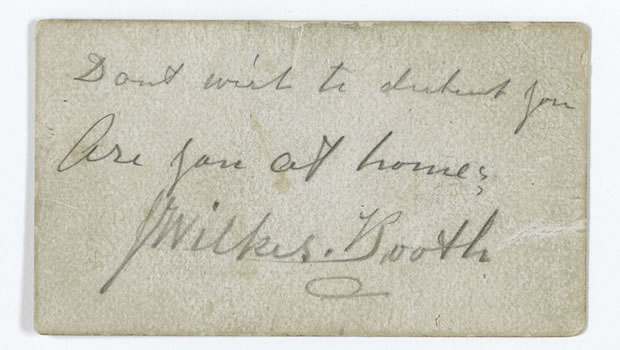
The vice president was also targeted for a synchronized assassination that night. Booth left this when he visited the hotel where Vice President Andrew Johnson resided. It says: "Don't wish to disturb you. Are you at home? J. Wilkes Booth."
https://panorender.com/lincoln-assassination-seen-on-the-virtual-tour
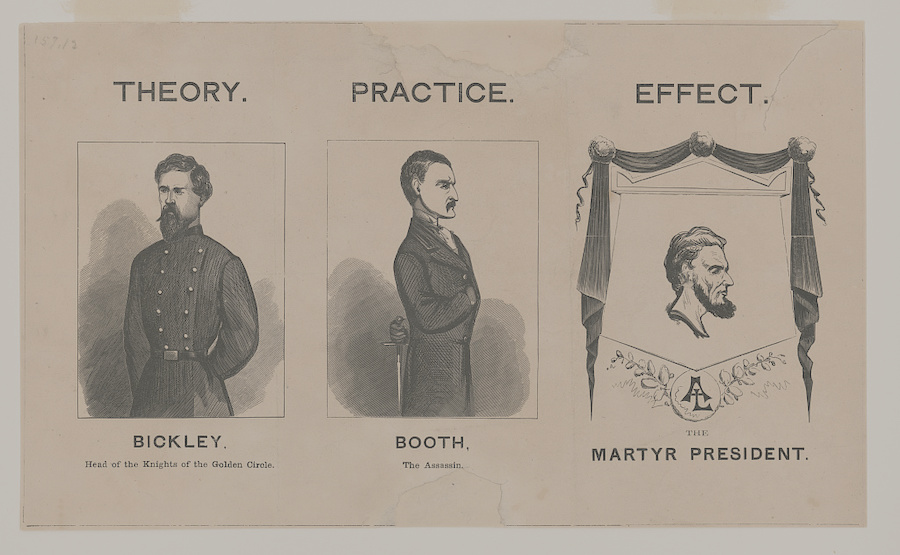
An unusual, three-part wood engraving attributing John Wilkes Booth's assassination of Abraham Lincoln to the influence of the proslavery secret society, the Knights of the Golden Circle. Lincoln was shot by Booth on April 14, 1865, while attending Ford's Theatre in Washington. In the first panel (left) is a three-quarter length portrait of George W. L. Bickley, the "Head of the Knights of the Golden Circle." Above him is the word "Theory." The central panel--"Practice"--shows John Wilkes Booth in profile holding a dagger behind his back. The "Effect" is the death of President Lincoln, whose profile portrait at right is framed by swags of black drapery. Beneath the portrait are Lincoln's initials and olive branches.
| The Conspirators: | ||||||||
|---|---|---|---|---|---|---|---|---|
| https://www.nps.gov/foth/learn/historyculture/the-lincoln-conspirators.htm | ||||||||
In the two weeks following the assassination, hundreds of individuals were detained, questioned, and in some cases imprisoned, as federal agents tried to determine who was responsible for the assassination of President Lincoln.
The investigators settled on ten individuals they believed were responsible for the crime:
Many others who assisted Booth in the plot or in his escape were brought in for questioning, but were released due to lack of evidence. | ||||||||
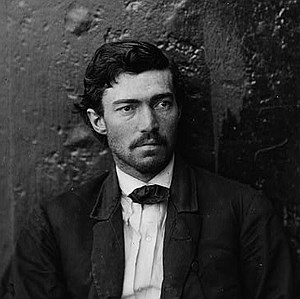 Samuel Bland Arnold
A childhood friend of John Wilkes Booth, both were schoolmates at St. Timothy's School in Catonsville, MD in the 1850s. Arnold was a veteran of the Confederate Army, and was recruited by Booth to participate in the kidnapping plot in 1864. Arnold parted ways with Booth on March 15, 1865, following an argument in which he told Booth that his kidnapping plans were impractical. Arnold was not in Washington D.C. at the time of the assassination and probably did not have any knowledge of the plot to murder the president. He was arrested at Fortress Monroe Virginia on the morning of April 17, 1865, and investigators tied him to Booth and the kidnap plot. He was tried and convicted and sentenced to life in prison at Fort Jefferson in the Dry Tortugas off the Gulf Coast of Florida. Pardoned by President Andrew Johnson in 1869, Arnold lived until 1906, long enough to publish a memoir he hoped would vindicate his name. He is buried in Green Mount Cemetery in Baltimore, the same final resting place as John Wilkes Booth and conspirator Michael O'Laughlen.
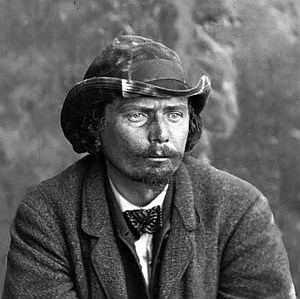 George A. Atzerodt
30 years old, German-born Atzerodt was a carriage painter and boatman who was known to ferry Confederate spies and supplies across the Potomac River between Maryland and Virginia. Recruited by Booth for his knowledge of the waterways and his ability to handle a boat, both of which would be useful in transporting a kidnapped President Lincoln. After Booth's plans changed from kidnapping to murder, he assigned Atzerodt to kill Vice President Andrew Johnson, who was staying at the Kirkwood Hotel a few blocks from Ford's Theatre. Atzerodt instead ordered a drink at the Kirkwood bar and lost his nerve, wandering the streets of the city through the night. Azterodt fled Washington and was arrested on April 20, apprehended at the house of his cousin Hartman Richter in Germantown, MD. Atzerodt was tried and convicted for conspiracy to commit murder, and he was executed by hanging on July 7, 1865. He is buried in an unmarked grave at Glenwood Cemetery, Washington, D.C.
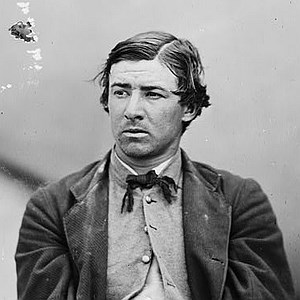 David E. Herold
23 years old, Herold first met Booth in 1863 after a performance at Ford's Theatre. Herold was friends with George Atzerodt and John Surratt and had met Michael O'Laughlen through Atzerodt. His role in the assassination plot was to guide Powell to Secretary of State Seward's home and then aid his escape out of the city. He fled after hearing the screams coming from the Seward home following Powell's attack. He met up with Booth in Maryland and stayed with Booth until his capture at Garrett's farm. Herold was brought back to Washington D.C. for trial. Described in the trial as dull-witted and simple-minded in an attempt to convince the court that he was easily duped by Booth and should not be held responsible for his role. Herold had actually studied pharmacy at Georgetown and worked as a druggist's assistant. and his answers to an interrogator suggested a quick and agile mind. David Herold was convicted and hanged July 7, 1865. He is buried in Congressional Cemetery, Washington, D.C., his grave site marked only by the tombstone of his sister buried beside him.
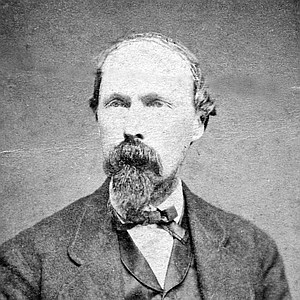 Dr. Samuel Alexander Mudd
32 years old, Mudd was a graduate of St. John's College and Georgetown College (now University), and got his medical degree from the Baltimore Medical College in 1856. He and his wife Sarah had 4 children, and they lived on the 200+ acre tobacco plantation "Oak Hill," near Bryantown Maryland, that had been in the Mudd family for seven generations. He met Booth on several occasions and his house may have been planned as a safe stop for the kidnap plot. Booth and Herold arrived at Dr. Mudd's farm at about 4 a.m. on April 15, seeking medical assistance for Booth's broken leg. Doctor Mudd treated the leg and made a splint for him, and allowed Booth and Herold to stay upstairs the rest of the night. Booth and Herold left Dr. Mudd's the next afternoon, heading into the Zekiah Swamp and the route southward. Mudd later insisted that he did not recognize Booth and that he did not know that Lincoln had been assassinated. He was evasive and nervous while questioned, was tried and convicted of conspiring to kill the president, and given a life sentence at hard labor. He was sent to Fort Jefferson in the Dry Tortugas, Florida. He was pardoned and released by President Andrew Johnson in 1869. He lived the rest of his life at his farm and fathered five more children. Dr. Mudd died January 10. 1883 at the age of 49 and is buried In the cemetery at Saint Mary's Catholic Church in Bryantown, Maryland.
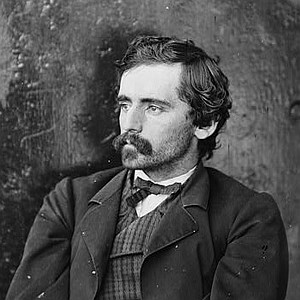 Michael O'Laughlen
O'Laughlen was a childhood friend of John Wilkes Booth, living across the street from the Booth family in Baltimore. An ex-Confederate soldier and one of Booth's earliest recruits in the fall of 1864, O'Laughlen agreed to assist in the plot to kidnap President Lincoln. At trial, he admitted to participating in the failed abduction of Lincoln on March 17, 1865, but withdrew from other abduction attempts when it seemed that Booth's plans were not at all feasible. He is unlikely to have had any role in the assassination plot. O'Laughlen turned himself into authorities Monday, April 17, two days after the assassination. He was tried as a conspirator and sentenced to life in prison. Sent to Fort Jefferson in the Florida Keys, he died there of yellow fever in 1867. He is buried in Green Mount Cemetery, Baltimore, MD, in the same cemetery as John Wilkes Booth and Samuel Arnold.
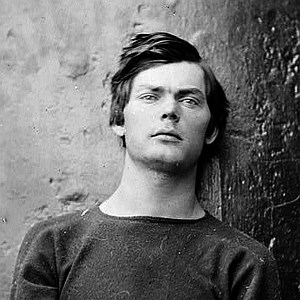 Lewis Thornton Powell (alias "Lewis Paine")
21 years old, Powell was a former Confederate soldier with the 2nd Florida Infantry who was wounded and captured at the battle of Gettysburg. After recovering from his wounds, he escaped and joined Mosby's Rangers in Virginia. Powell was introduced to Booth through John Surrat in January 1865, an became an important part of Booth's plan to kidnap President Lincoln. He used the aliases "Paine" or "Payne" so that his family would not find out about his role in the kidnap or murder if he was killed in the attempts. Tall and strong, he was recruited to bring the muscle for the kidnapping. When the plan failed and Booth turned to murder, he assigned Powell to kill Secretary of State William Seward. Powell entered the Secretary's home in Lafayette Square and severely injured Seward and others in the house. He was tried and convicted, and executed by hanging on July 7, 1865. His remains were moved from place to place, and the only remains to survive, his skull, was eventually interred in the family plot at Geneva Cemetery in Geneva, Florida.
 Edman "Ned" Spangler
40 years old, Spangler was a stagehand and carpenter at Ford's Theatre who had met John Wilkes Booth years earlier while doing carpentry work on the Booth home "Tudor Hall" in Bel Air, Maryland. Spangler renewed their friendship while both were working at Ford's. Booth asked Apngler to hold his horse in the back alley behind Ford's the night of the assassination, and Spangler turned that duty over to young "Peanut John" Burrows. It is unlikely that Spangler knew anything about Booth's plots or intent. Even so, he was found guilty of helping Lincoln's assassin escape and was sentenced to six years of hard labor at Fort Jefferson Prison in the Dry Tortugas, Florida. Spangler was befriended by Dr. Mudd in prison, and when both were pardoned by President Johnson in 1869, he moved to Maryland and did odd jobs around the Mudd farm until his death in 1875. He is buried In St. Peter's Cemetery in Waldorf, Maryland.
 John Harrison Surratt, Jr
21 years old, Surratt was one of Booths most valuable and capable conspirators. He was a Confederate spy with a college education who ran mail and correspondence across Union lines, and worked with Confederate Secret Service agents in Canada. He introduced Herold and Atzerodt to Booth, and also brought Powell into Booth's orbit. John took part in the failed abduction attempt in March 1865, but was in Elmira New York at the time of the assassination. He fled to Canada, then England, when he heard news of the crime. He lived as a fugitive for several years, serving with the Papal Guards for the Vatican until he was recognized and apprehended in Egypt in 1866. Extradited back to the United States, he was tried by a civilian court in 1867. The case resulted in a hung jury and Surratt was set free and never tried again. John Surratt died in 1916, the last surviving Lincoln conspirator. Many blamed him for his mother's death, believing that had he surrendered himself in 1865, he would have been hanged in place of his mother. He is buried in New Cathedral Cemetery, Baltimore, MD.
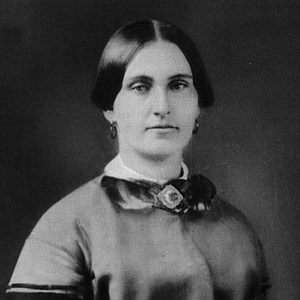 Mary Elizabeth Surratt (nee Jenkins)
Mary Surratt, a southern sympathizer, owned a boarding house in Washington D.C. where the conspirators met and planned the kidnap, and eventually the assassination, of President Lincoln. President Johnson called her boarding house "the nest that hatched the egg." Both Powell and Atzerodt also boarded there briefly. Following the assassination, John Wilkes Booth and David Herold stopped for supplies at the Surratt Tavern in Surrattsville Maryland (today Clinton MD), which Mary owned and had leased out to tenant John M. Lloyd. Earlier on the day of the assassination, she rode down to the tavern and gave Lloyd a package that Booth had given her earlier that morning. According to Lloyd, she asked him to "have the shooting Irons ready". Due mainly to the testimony of Lloyd, she received the death sentence for conspiring to assassinate Abraham Lincoln. Despite five of the judges at the trial asking that she be granted clemency by President Johnson because of her age and sex, she was put to death by hanging on July 7, 1865. She was the first woman executed by the federal government in the United States. Her guilt or innocence, and the appropriateness of the death penalty, has been much debated by historians. She is buried at Mount Olivet Cemetery, Washington, D.C. The Surratt boarding house still stands today at 604 H St N.W. Washington D.C., and is currently in use as a Chinese restaurant and karaoke bar.
|
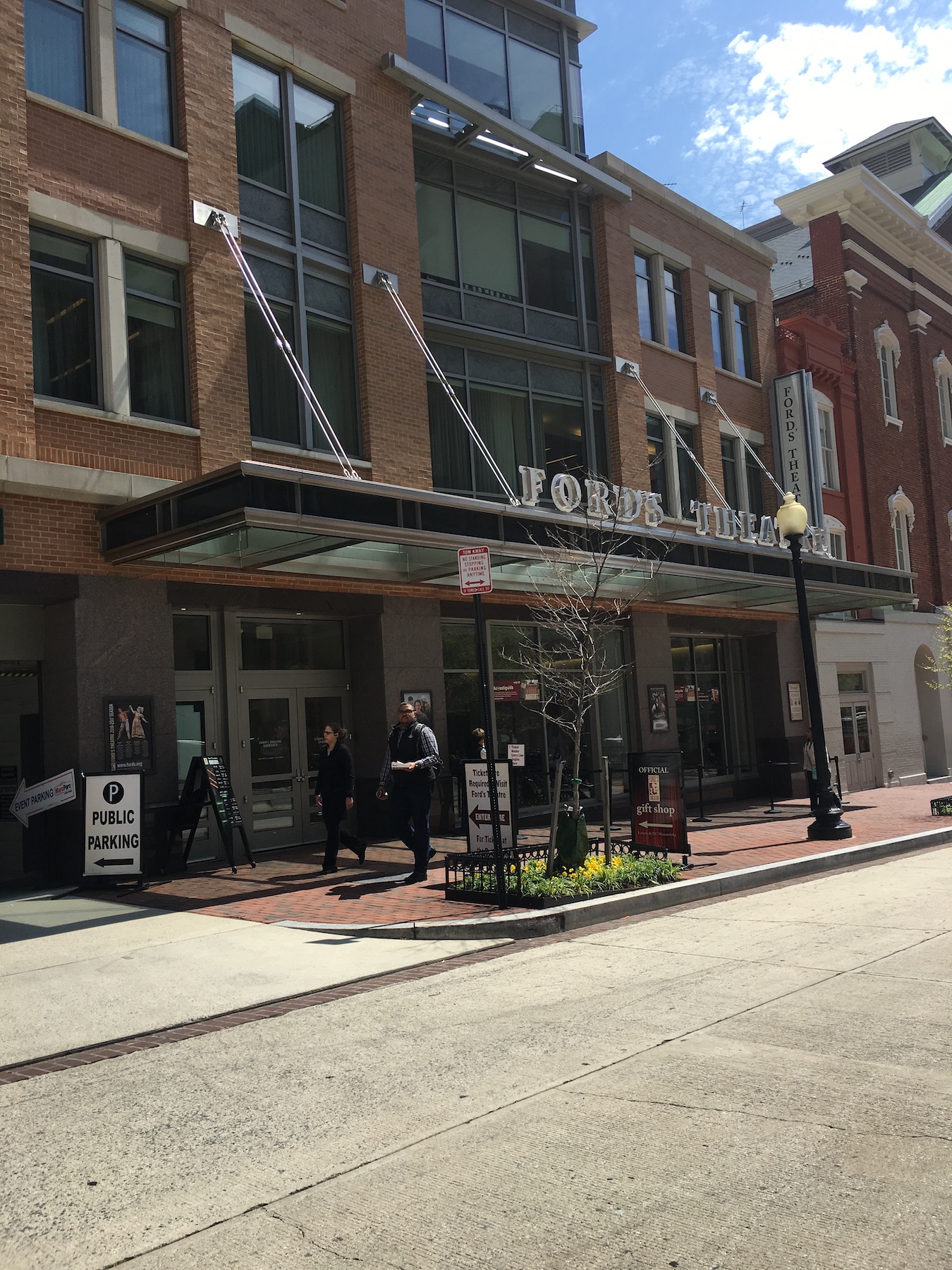

Playbill for Friday evening, April 14, 1865 featuring Laura Keene in Our American Cousin
https://www.loc.gov/item/scsm000300
Our American Cousin:
A three-act play by English playwright Tom Taylor. It is a farce featuring awkward, boorish American Asa Trenchard, who is introduced to his aristocratic English relatives when he goes to England to claim the family estate. The play premiered with great success at Laura Keene's Theatre in New York City in 1858, with Keene in the cast, the title character played by Joseph Jefferson, and Edward Askew Sothern playing Lord Dundreary. The play's long-running London production in 1861 was also successful.
The play achieved great renown during its first few years and remained very popular throughout the second half of the 19th century. It is best known in modern times as the play that U.S. President Abraham Lincoln was attending in Ford's Theatre in Washington, D.C., when he was assassinated by John Wilkes Booth at the end of the American Civil War.

Printed Theatre Ticket, unused, for a Reserved Chair in the Orchestra section at Friday's performance of "Our American Cousin" Ford's Theatre, Washington, April 14, 1865, with large circular ink stamp, "Ford's Theatre/ This Night Only / April 14, 1865." 4 1/8 inches by 1 3/4 inches, on thick card stock with a bright yellow surface, and bearing the printed signature of manager James R. Ford.
Don't know the manners of good society, eh? Well, I guess I know enough to turn you inside out, old gal — you sockdologizing old man-trap..."
John Wilkes Booth slipped unnoticed into the Presidential box and, standing four feet away from the President, discharged a single bullet from a derringer into the back of Lincoln's head. The short-barreled pocket pistol shot a round lead ball at a very low muzzle velocity - about that, say, of today's air guns. It was enough, however, to render Lincoln unconscious and paralyzed. As Booth escaped from the theater, a young Army surgeon, Charles Leale, made his way through the audience to Lincoln's side. He determined that the wound was mortal, and ordered the stricken President carried across the street to a neighboring boarding house. There, because he was too tall to fit lengthwise, Lincoln was laid diagonally across a small bed - which, on previous occasions, had been slept in by his assassin, Booth.
Ford's Theatre is infamous for being the site of the assassination of United States President Abraham Lincoln on April 14, 1865Ford's Theatre:
- Located in Washington DC
- Opened in August 1863
1865:
After being shot in the head, the fatally wounded 56-year-old Lincoln was carried across the street to the Petersen House, where he died the next morning.
- The theater was later used as a warehouse and office building, and in 1893 part of it collapsed, causing 22 deaths.
On June 9, 1893, the front section of the three interior floors collapsed when a supporting pillar was undermined during excavation of the cellar, killing 22 clerks and injuring another 68. This led some people to believe that the former church turned theater and storeroom was cursed
- The building was repaired and Record and Pension Office clerks were moved back on July 30, 1894.
- In 1928, the building was turned over from the War Department Office to the Office of Public Buildings and Parks of the National Capital. A Lincoln museum opened on the first floor of the theater building on February 12, 1932—Lincoln's 123rd birthday.[11] In 1933, the building was transferred to the National Park Service.
- It was renovated and re-opened as a theater in 1968. The presidential box is never occupied.
- During the 2000s, it was renovated again, opening on February 12, 2009, in commemoration of the bicentennial of Lincoln's birth. It has a current seating capacity of 665.
The Ford's Theatre Museum beneath the theater:
The collection includes multiple items related to the assassination:
- The Derringer pistol used to carry out the shooting
- Booth's diary
- The original door to Lincoln's theater box
- His coat (without the blood-stained pieces)
- The blood-stained pillow from the President's deathbed.
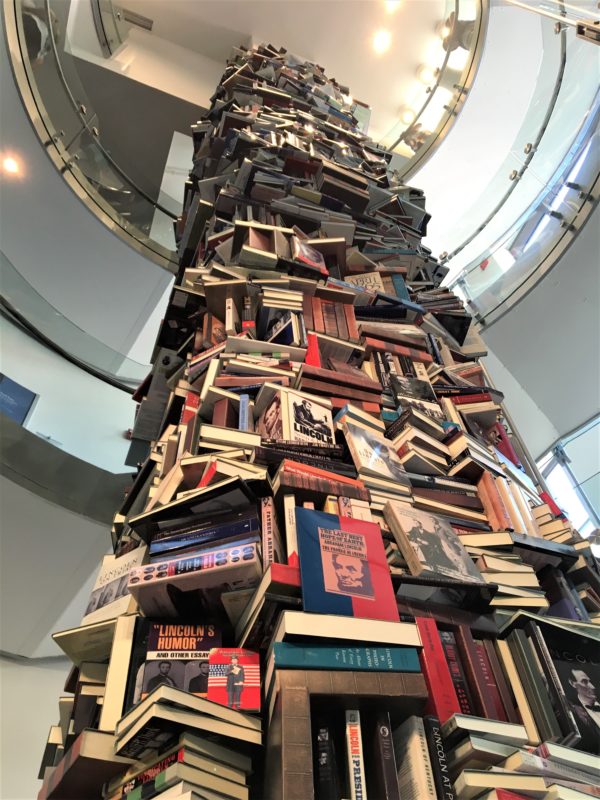
At the end of the Museum, there is a three-story stack of books - every one about Abraham Lincoln. It's surrounded by a circular staircase.
